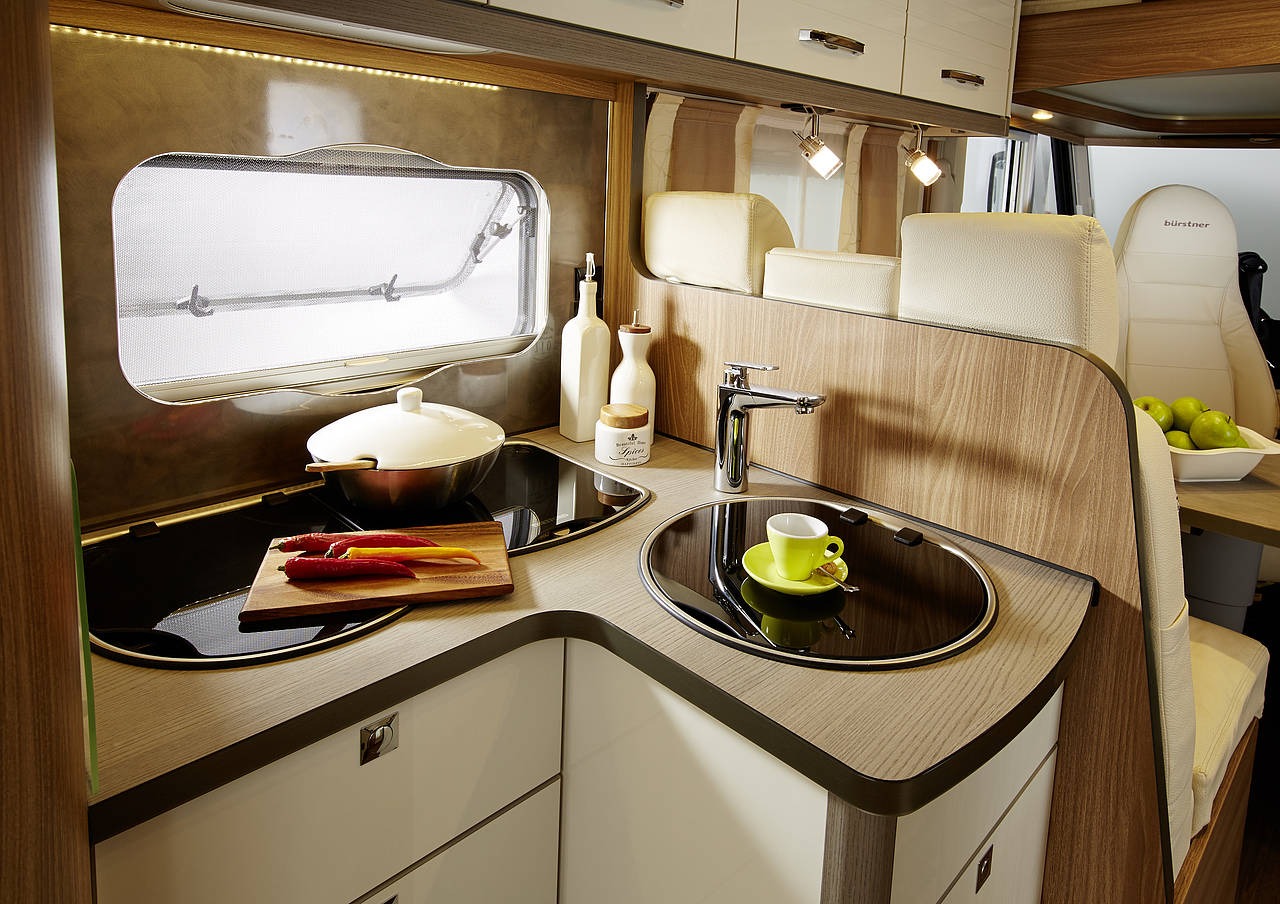
Whether you’re a food traveller looking for local ingredients or an adventurer needing quick meals to fuel your outdoor experiences, the kitchen is where magic happens — it’s the soul of your motorhome.
In this guide, we review the most functional kitchen layouts, assess which appliances work best in a motorhome kitchen, discuss kitchen storage space and look at kitchen lighting.
| Contents |
When viewing motorhome kitchens, try not to compare them with your kitchen at home — but rather with a camping kitchen.
The motorhome kitchen — a compromise
Motorhome kitchens will always be a compromise on space and storage because of the limited interior room available. However, most people don’t choose their ideal RV based on the kitchen. It’ll be a factor in your final decision — just not the main one.
Compared to your home kitchen, the motorhome kitchens you view will have one substantial difference — size. Expect them to be a lot smaller.
How do you prefer to cook while travelling?
.jpg?width=1278&height=852&name=RS23873_Wilderness-VideoLab11-lpr%20(1).jpg)
When weighing up motorhome kitchen layouts, one of your most important criteria should be how you cook. It may be different from cooking at home as you’ll be in a different frame of mind — on holiday or in camping mode.
Think about each aspect of cooking, including the:
- Frequency you intend to cook — versus how often you plan to eat out
- Appliances you need — whether a microwave or an oven is necessary, or if gas hobs are enough
- Amount of food you’ll store — depending on whether you plan meals around a small selection of commonly used ingredients or require more space for storing a wider variety of foodstuffs
- Ratio between indoor and outdoor cooking — how regularly you’ll need to use a barbecue.
A second cooking option
Carrying a barbecue in your motorhome’s garage is ideal for cooking on the road in summer. However, at other times of the year and with fast-changing New Zealand weather, it’s wise to be able to comfortably cook inside your recreational vehicle too.
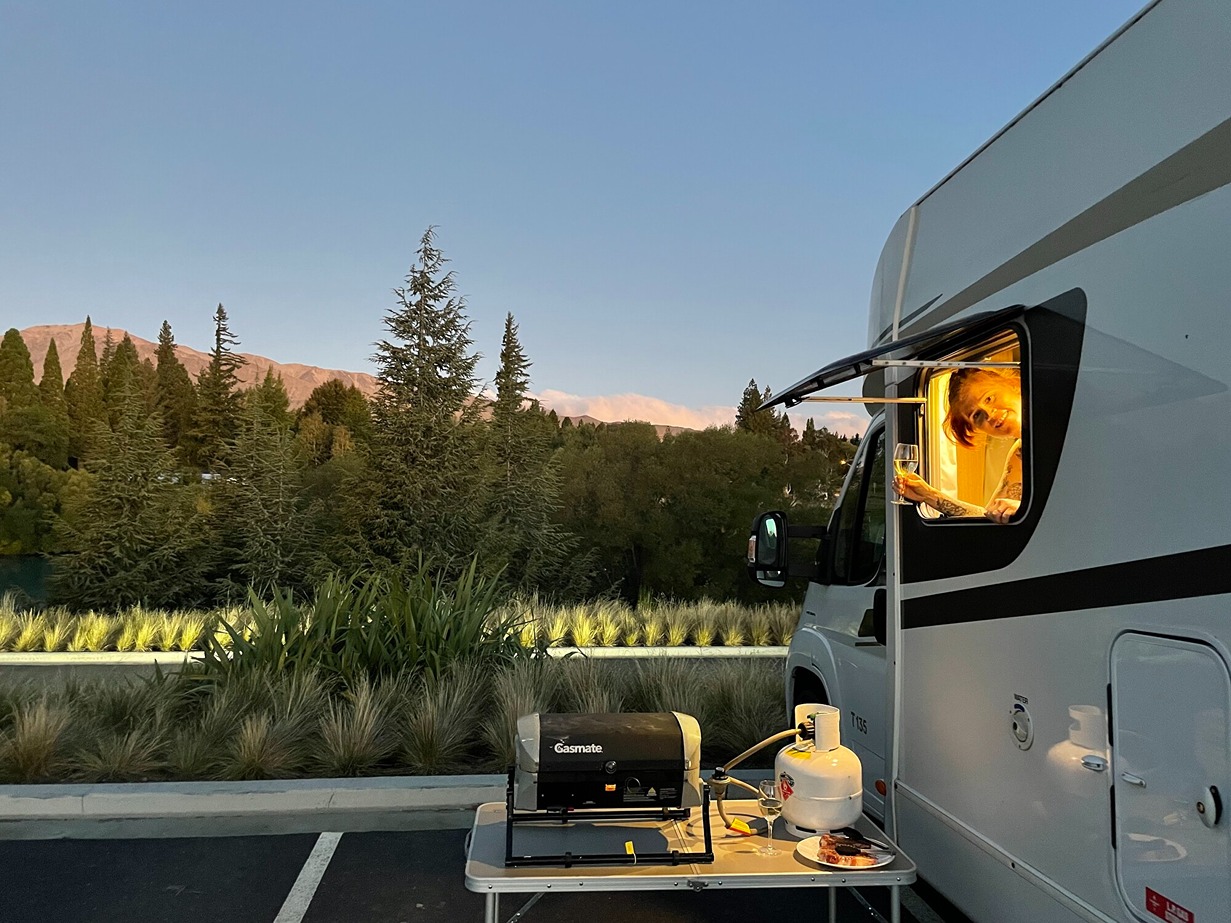
Even if you mainly plan to stay at commercial campgrounds, it’s handy to have access to your own motorhome kitchen oven and barbecue — should the communal camp kitchen be busy.
Check out our top barbecue tips for cooking on the road.
Types of motorhome kitchens
Modern motorhomes offer surprisingly functional kitchen layouts and come in a variety of different configurations like L-shaped, galley, slide-out and exterior.
L-shaped kitchens
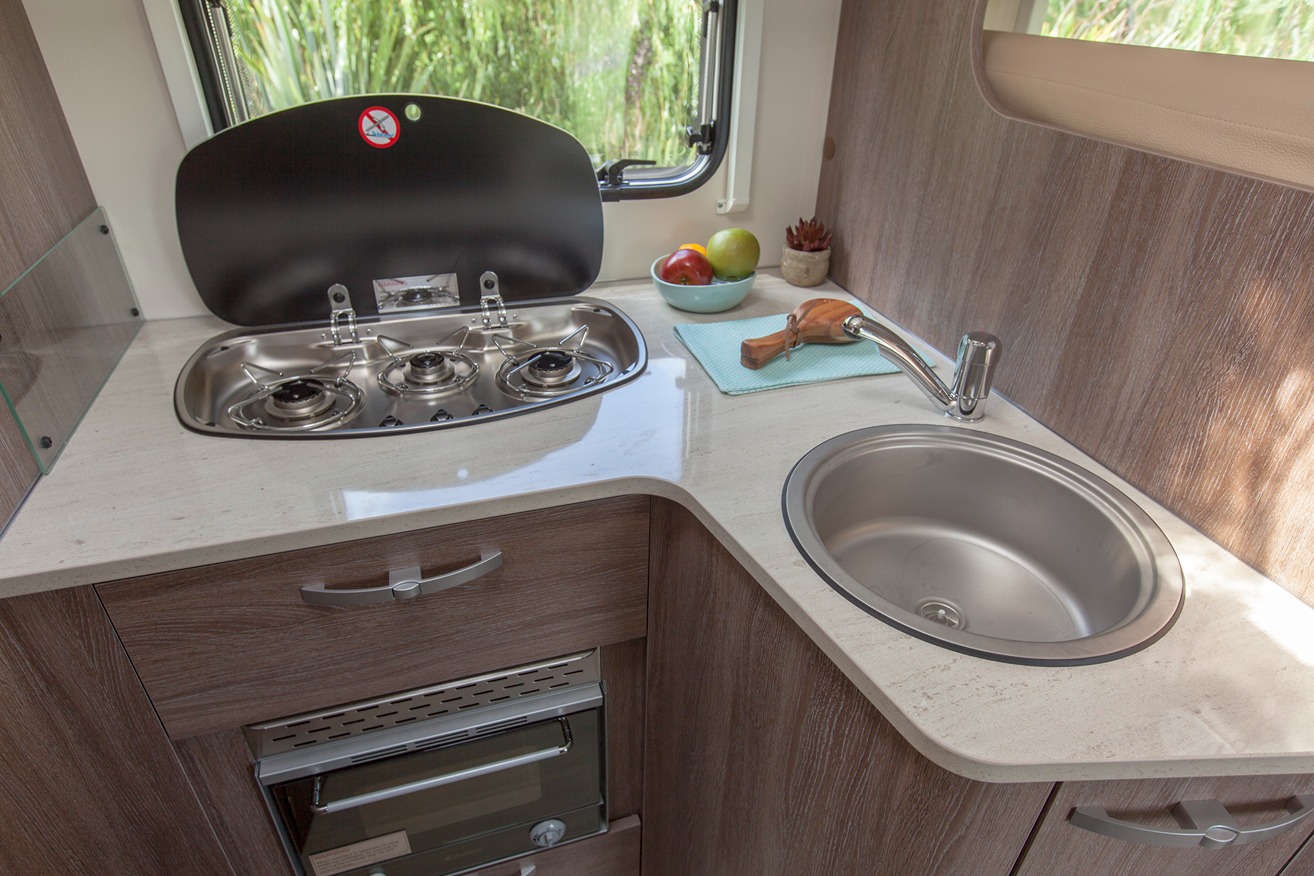
Many higher-end motorhome brands, particularly the European ones, favour an L-shaped kitchen. Designed to make the space feel more open and accessible, they typically include a sink, stove and an oven — along with overhead cabinets for storage.
Traditionally, L-shaped kitchens had the return placed between the kitchen and the living area. Most modern motorhome designs have the return located next to the bathroom — helping to open up the space.
|
What is a return? A return is the section of countertop that extends from the main bench area to create extra workspace. As space is at a premium inside a motorhome, the return may be foldable or retractable to maximise the usability of the area while you’re preparing food and cooking. |
Benefits of L-shaped kitchens
Modern L-shaped motorhome kitchens have a harmonious blend of functionality, space efficiency and aesthetic appeal. Benefits include:
- Optimal use of space — L-shaped kitchen designs use the corner efficiently so you’re maximising the amount of usable bench and cupboard area
- More ergonomic workflow — reducing unnecessary movement to make cooking and cleaning less demanding
- A natural social area — the L-shape layout helps conversations to flow freely between those preparing meals and those relaxing in your living area.
Galley kitchens
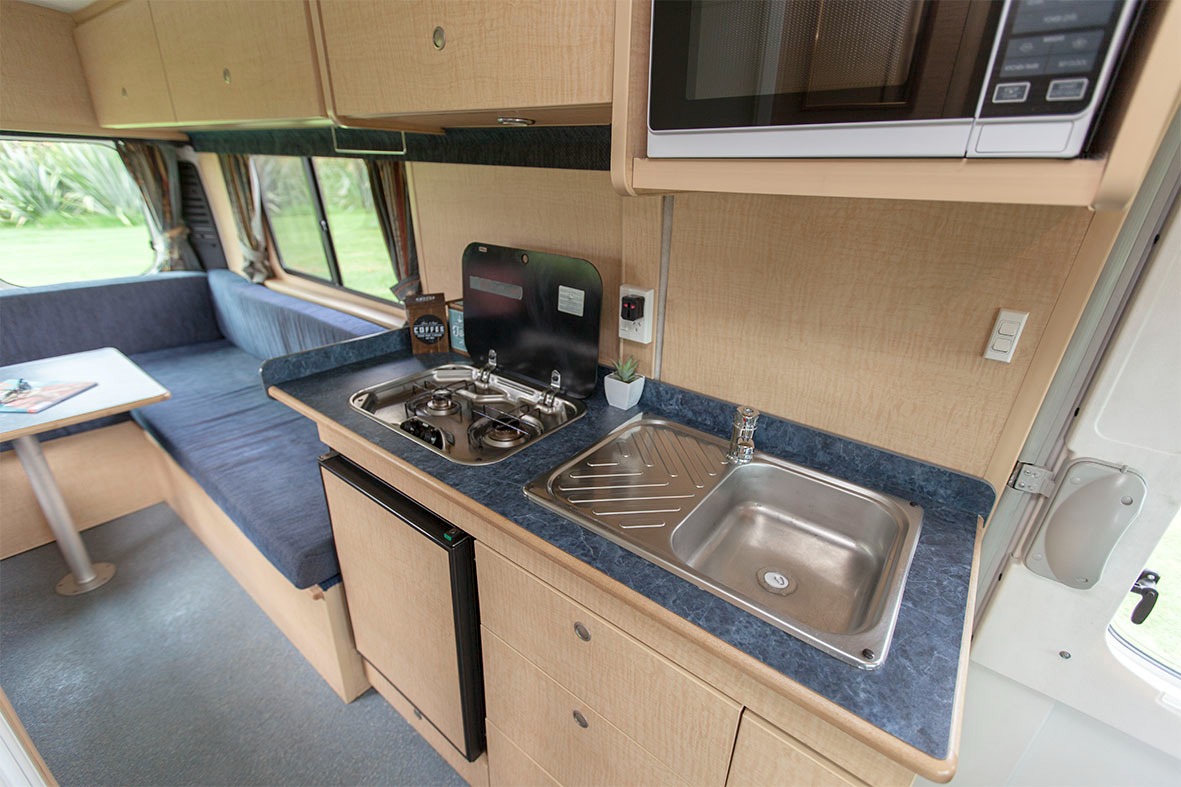
A galley kitchen is common in standard motorhomes. It's a rectangular kitchen block on one side of your motorhome and will often take up a fair amount of space.
Benefits of galley kitchens
Well-suited to the spatial constraints of motorhomes, galley kitchens offer:
- More bench space — a galley kitchen is one of the larger set-ups in a motorhome and has a decent amount of bench space
- Ease of use — such a simple design makes the galley kitchen easy to clean and maintain.
While having a galley kitchen means plenty of space for preparing and cooking meals, it also means less space elsewhere — like in your motorhome’s living room, bathroom or bedroom.
Galley kitchens are linear by nature so they usually extend along a significant portion of one side of a motorhome. Such a layout limits the size of other areas which may need to be designed more compactly to fit the remaining space.
Slide-out kitchens
The smallest type of motorhome kitchen, a slide-out can transform a compact space into a larger, more functional area. They’re not constrained by your motorhome’s existing dimensions like other kitchen types.
Slide-out kitchens usually contain up to three gas hobs, a tiny sink and a mini workspace — all in one pull-out drawer.
Benefits of slide-out kitchens
An innovative design solution, a few advantages of slide-out kitchens are:
- The feeling of more interior space — when your kitchen is packed away and you’re not utilising it
- Adaptability — pull out your kitchen when it’s time to prepare and cook meals, then push it back behind your cabinetry when it’s not in use.
Exterior kitchens
Some recreational vehicles may come with a dedicated cooking and food preparation area that’s accessible from the outside of the RV. Known as exterior kitchens, they’re less common in motorhomes but are worth looking into if you prefer to cook outdoors most of the time.
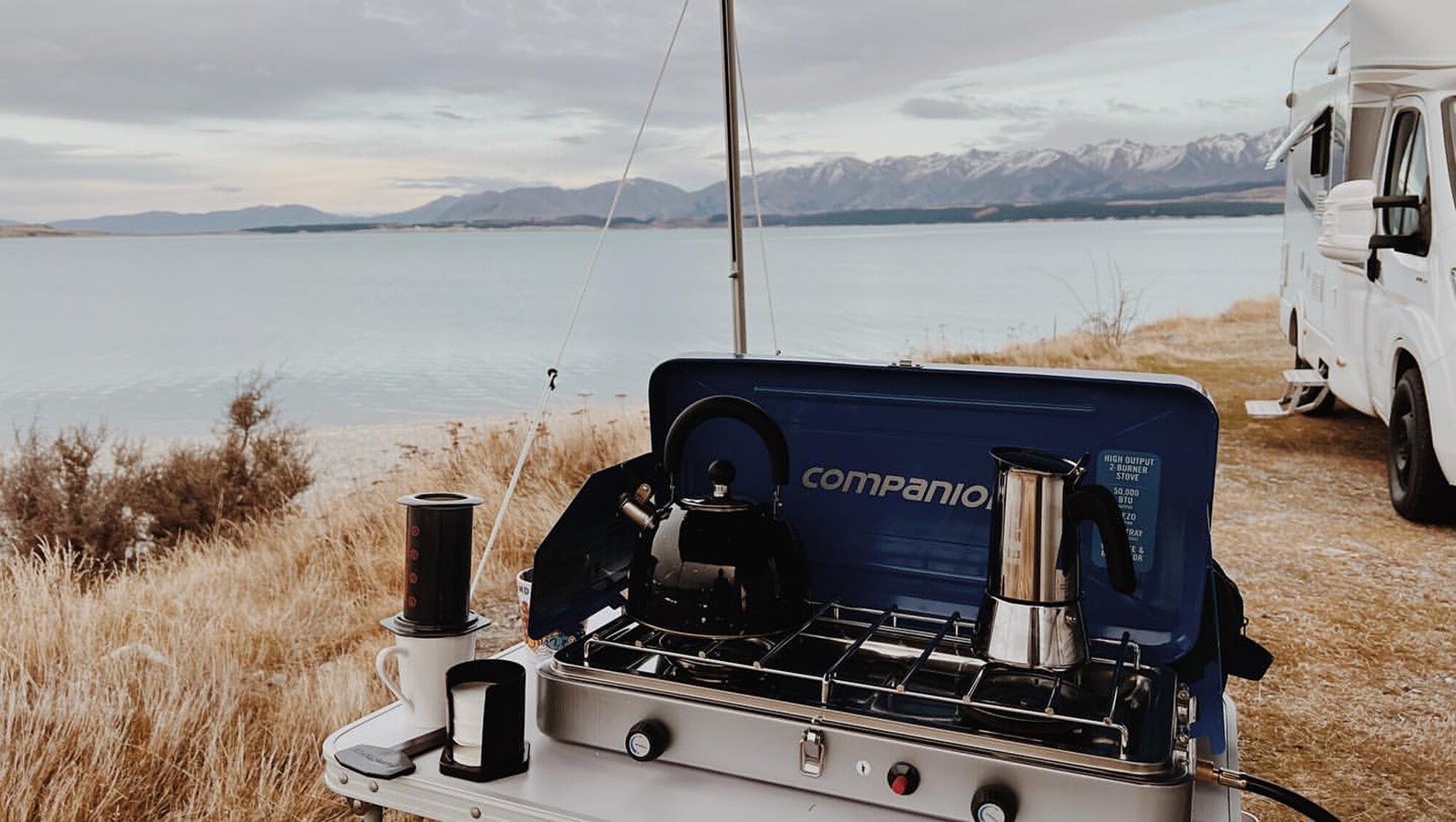
Varying in complexity, exterior kitchens range from a simple grill with a small prep area to configurations that include a stovetop, fridge, sink and plenty of bench space.
Benefits of exterior kitchens
The uniquely enjoyable experience of cooking outdoors comes with pros like:
- Cooking smells and heat stay outside — which can be especially preferable in hot summer temperatures
- Larger social gatherings are possible — with more space for your guests to mingle and enjoy the outdoor setting.
Exterior kitchens come with a few drawbacks, such as being heavily dependent on good weather. You’ll want to have the option of cooking inside if you strike seven days of rain in a row.
In larger motorhomes, exterior kitchens can be secondary ones. Though valuable external storage space is lost and extra weight may be added to the RV. Maintenance and cleaning can also be challenging as exterior kitchens are exposed to the elements while in use.
Find out about typical motorhome layouts and how they affect kitchen space.
|
Are European motorhome kitchens too small? European motorhome kitchens tend to be smaller than those installed in standard New Zealand-made RVs. That’s because in Europe they prioritise the beds — as motorhomes are designed to navigate narrow roads and fit smaller camping spaces which are common on the continent. As a result, designers usually make trade-offs in the kitchen and bathroom areas. |
Look for a functional layout
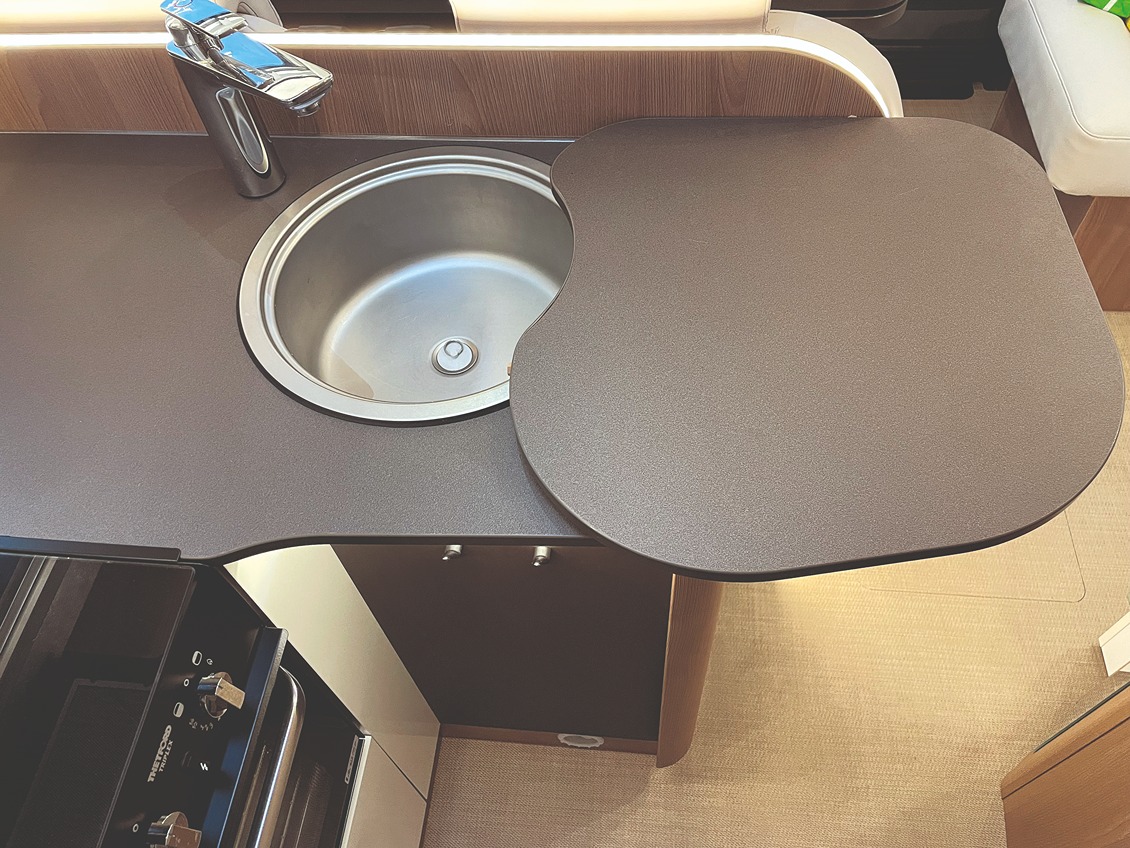
The size of your motorhome kitchen alone isn’t the best indicator as to how usable it will be. Check that it has a functional layout with enough space for you to move around while cooking.
You’ll also want fellow passengers to be able to access the bedroom and bathroom whilst you’re cooking — without having to squeeze past the chef or walk sideways.
Look out for functional and space-saving extras, including:
- Pull-out features — like a pull-out pantry that slides out from a narrow space with shelving or racks that hold cooking ingredients
- Extendable benchtops — also known as fold-out or pull-out countertops, designed to extend your working space
- Sink covers — that snugly fit over your motorhome’s kitchen sink giving you more benchtop space to work with.
|
Adapting from two sinks to one Space constraints in a motorhome mean that a single small sink is much more practical than a large one — or even the two sinks you may have in your home kitchen.
Try adjusting your kitchen routine to better work with one sink by:
• Utilising the over-the-sink cover — as preparation space or a chopping board • Taking a clean-as-you-work approach — to help keep your workspace clear • Preparing your meals in stages — for example, chop all of your ingredients before starting to cook • Planning simpler dinners — that need fewer pots, pans and utensils. |
The flow of your motorhome kitchen
Try to visualise how you’ll flow from preparing to cooking to cleaning up in your prospective motorhome kitchen. Imagine yourself going through the process of creating one of your favourite on-the-road meals — noting any issues you may face.
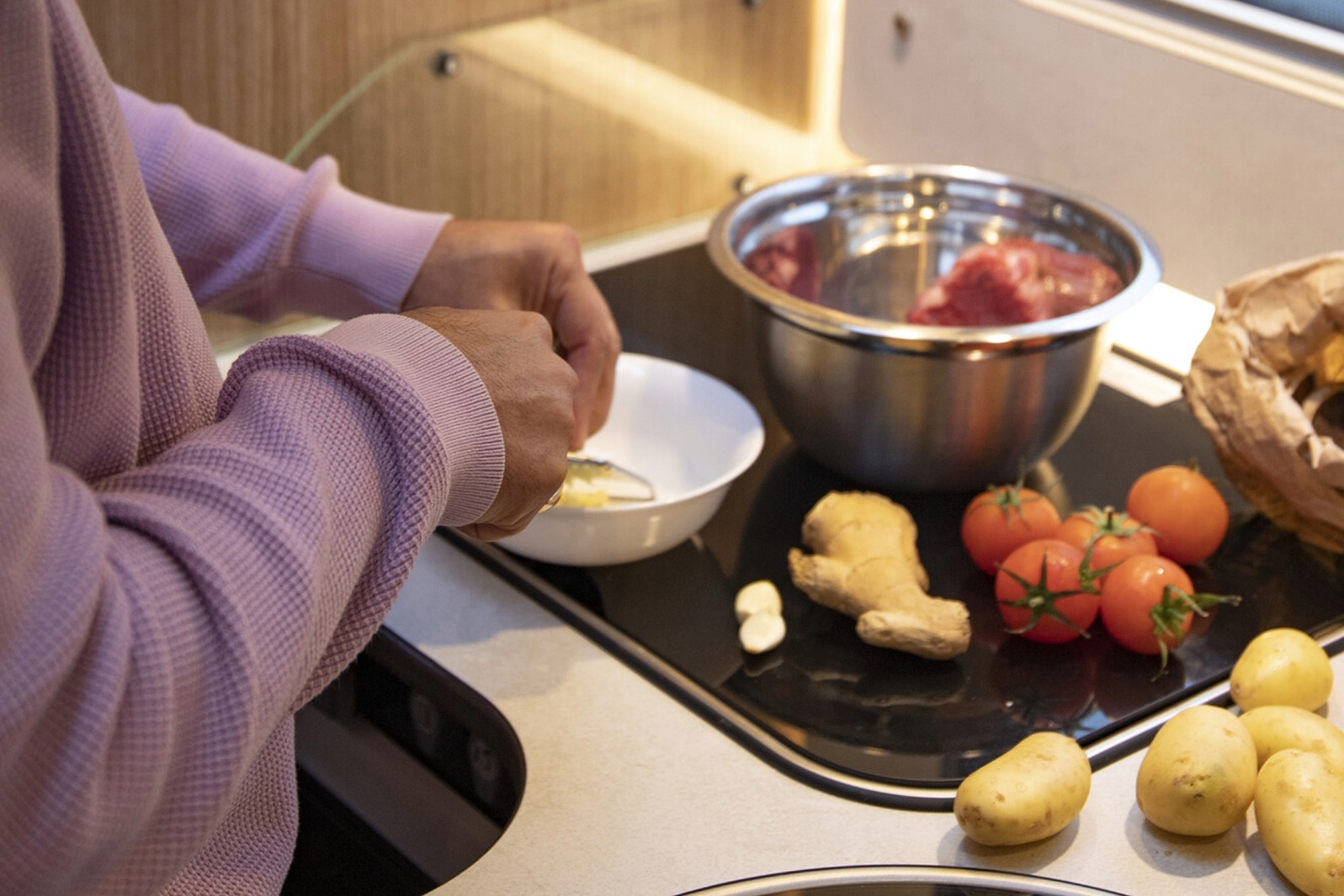
A few thoughts to keep front of mind are whether:
- The sink is coverable — so you can borrow extra bench space
- Your dining table can be used as a preparation surface.
Many seasoned motorhome owners cook differently in their motorhome kitchen than they do in their home. For example, they may choose simple meals that are easy to prepare and don’t require too many ingredients.
Assess the space for ease of cleaning up too. You’ll want to be able to use the sink effortlessly and clean up the bench easily.
See our buyers’ guide on what features to consider when buying a motorhome.
The most useful appliances in a motorhome kitchen
Like many other items in a motorhome, kitchen appliances are also designed small and compact.
Fridge
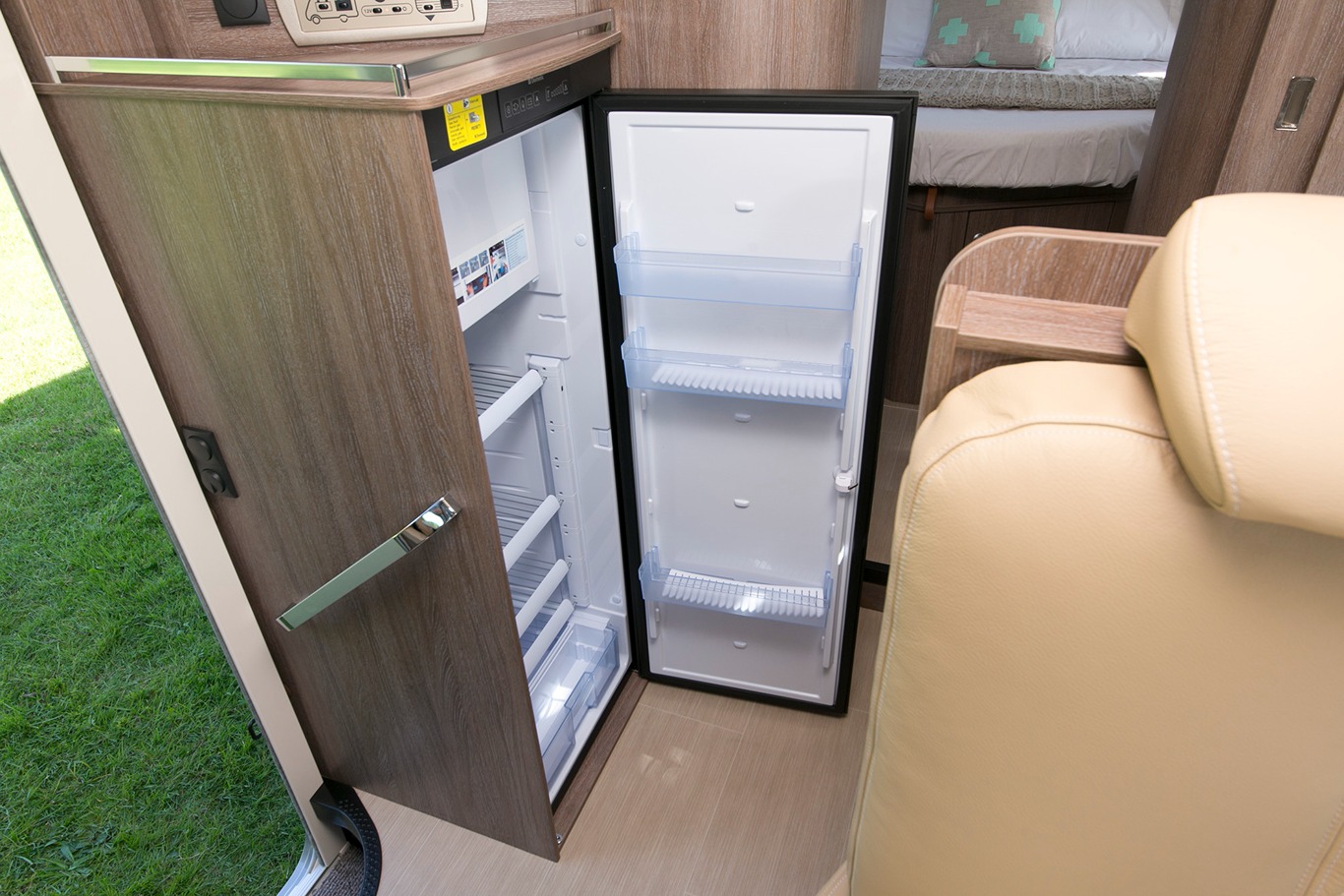
An appliance that can make the biggest difference to your cooking and shopping routine is your fridge. While most gas tops and ovens are relatively similar in size, the capacity of motorhome fridges varies hugely.
A relatively small fridge may be adequate if you’ll usually be travelling as a couple or a pair. It can also be enough if you mainly intend to camp close to civilisation and limit your time freedom camping.
You may need a relatively big fridge if you normally travel as two couples or a group of four. However, the larger your fridge, the more space it will take up — potentially reducing the available storage room in your motorhome.
Anything from small motel-style fridges right through to nearly full size fridge-freezers are possible. A bigger fridge can be a real asset if you freedom camp for long periods because you’ll be able to stock up on perishables and make them last several days.
Read our guide on the different types of RV fridges and coolers — and their pros and cons.
Powering your fridge
Just as important as the size of your fridge, is its power source. Many standard motorhomes have fridges that use either 240V mains power when you’re plugged in, or the 12V motorhome house battery when you’re off-the-grid.
In premium motorhomes, the fridge (or fridge-freezer) can generally operate from three different power sources — 240V mains power, the 12V house battery and gas. This is known as a three-way fridge.
Gas offers a real advantage if you’re planning to freedom camp for extended periods — as it’s very efficient.
Get more information on 12V battery motorhome power.
|
Cooling your motorhome fridge As a rule of thumb, the 12V house battery maintains your fridge temperature — while driving, for instance. The 240V mains power and gas (when used overnight) cools down the fridge.
Read our blog for some tips on how to keep beer cold in your motorhome. |
Gas hobs
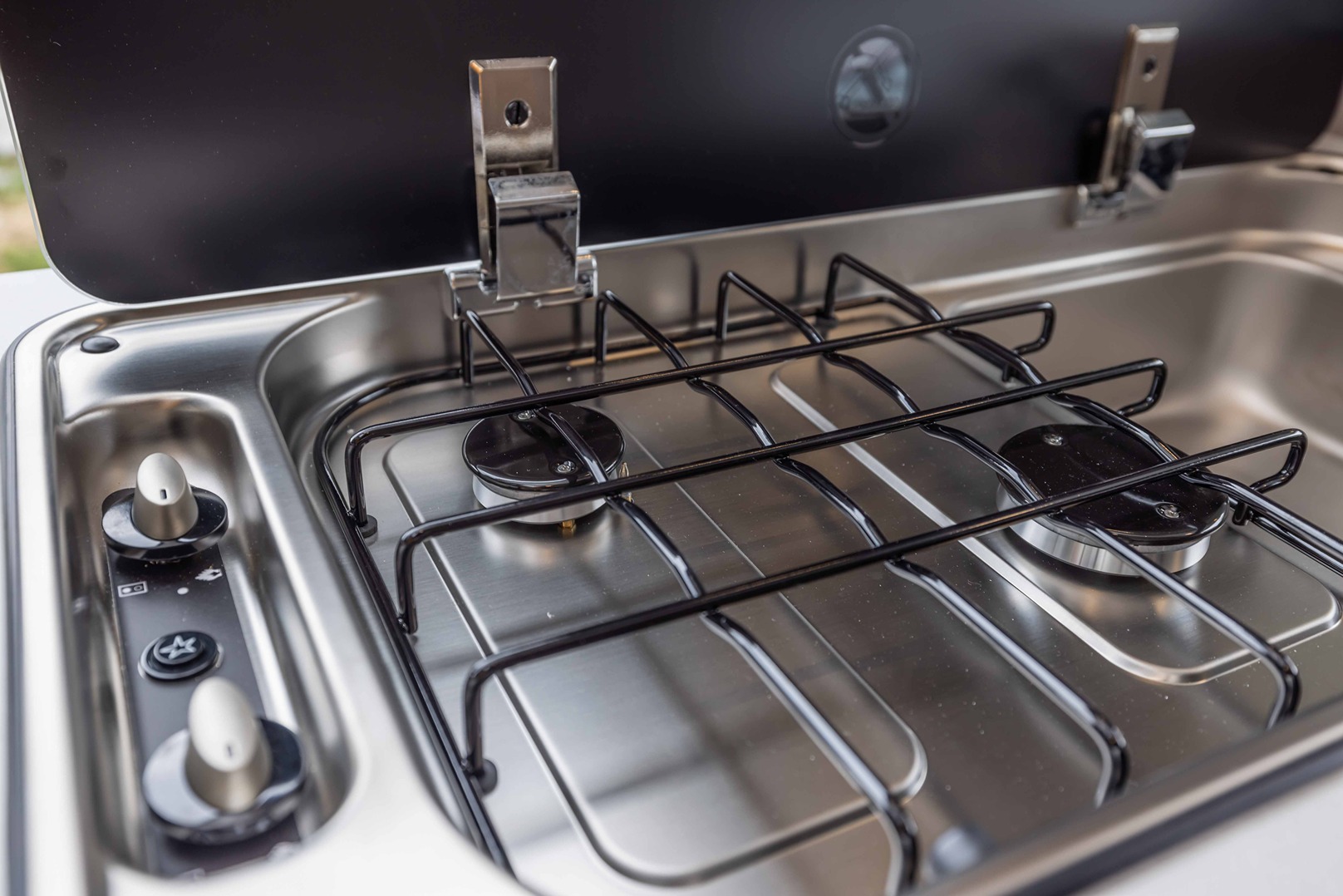
Most of your cooking will probably be done on gas hobs as they offer a very quick and efficient way to cook.
Premium motorhomes generally provide three gas hobs while some standard motorhomes may include an extra electric hob — which can only be used when plugged into mains power. The exact number depends on the motorhome’s size and its kitchen design.
High-end hobs will auto-ignite while standard ones will need a handheld igniter to use them.
Utilise the windows above your gas hobs to help properly ventilate your motorhome and:
- Reduce humidity levels — preventing the growth of mould and mildew
- Remove cooking odours — replacing them with fresh air
- Regulate the temperature inside your motorhome — to maintain a comfortable living environment
- Prevent the build up of heat over the summer months.
Find out about the key features of a well ventilated motorhome.
|
Check the gas setup Query where the motorhome’s gas bottle is located — and how to turn it on and off. Some higher-end motorhomes are designed to carry a main gas bottle plus a smaller reserve one. Space for a second gas bottle can be very handy as you’ll never unexpectedly run out of gas.
Learn about LPG gas safety in motorhomes. |
Oven and grill
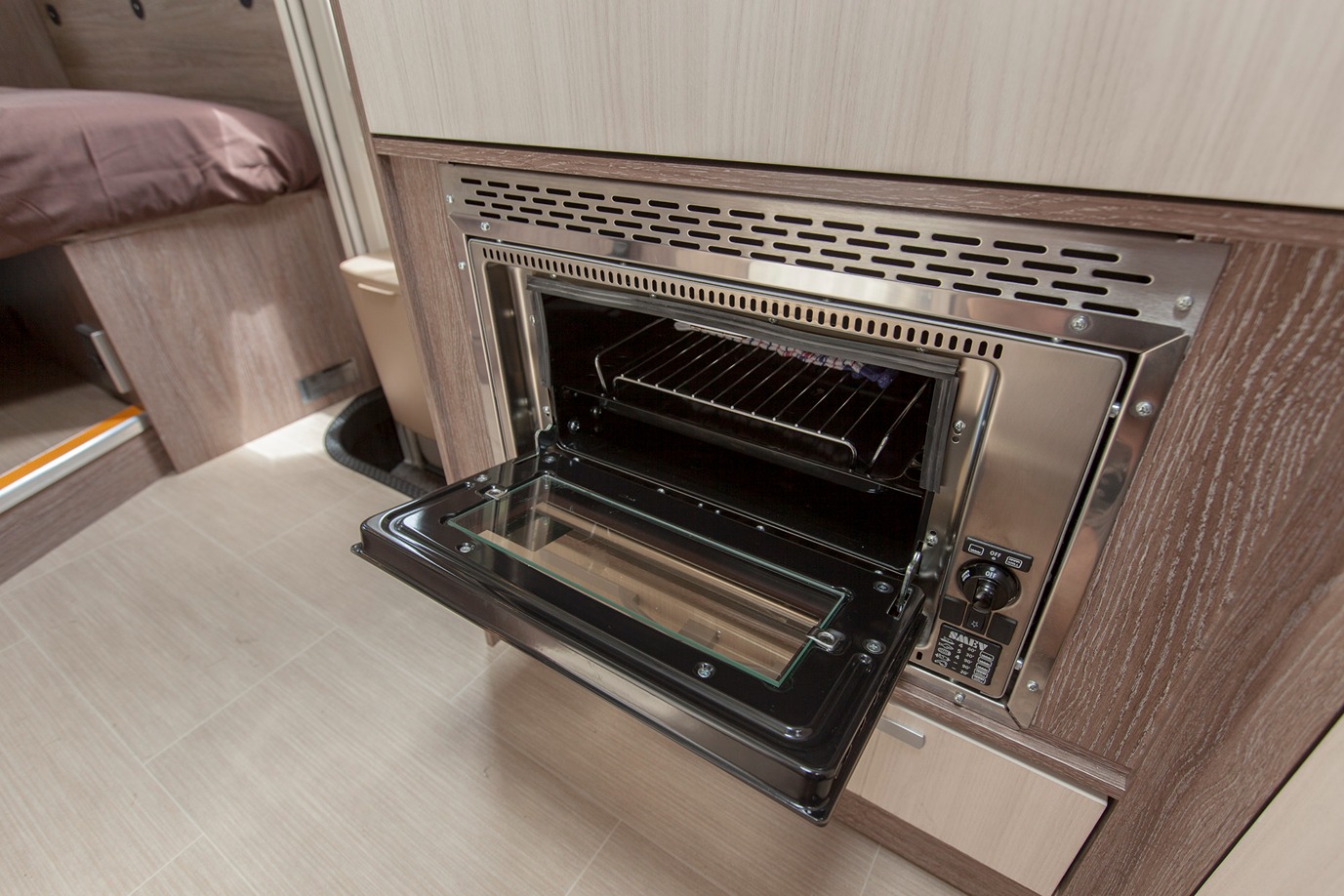
Plenty of recreational vehicles come with a grill and even an oven — both of which may be powered by gas or electricity. These motorhomes give you options for creating more diverse dinners.
When contemplating whether you need an oven, consider that:
- It takes up a significant amount of space
- You may not use it much
- The oven space could be utilised for storage — like more cupboards and drawers.
Question whether you really need an oven, or if gas hobs and a barbecue will suffice. Think about what kind of cooking you want to do while camping. You may only be interested in roasting different meats and fish for hearty dinners — or baking fresh scones and cakes on rainy days as a hobby.
|
Verify the motorhome’s water capacity Water capacity will determine how long you can freedom camp without having to top up — or discharge wastewater. Check the size of the motorhome’s fresh and wastewater tanks, and aim to conserve water where possible. |
Other appliances
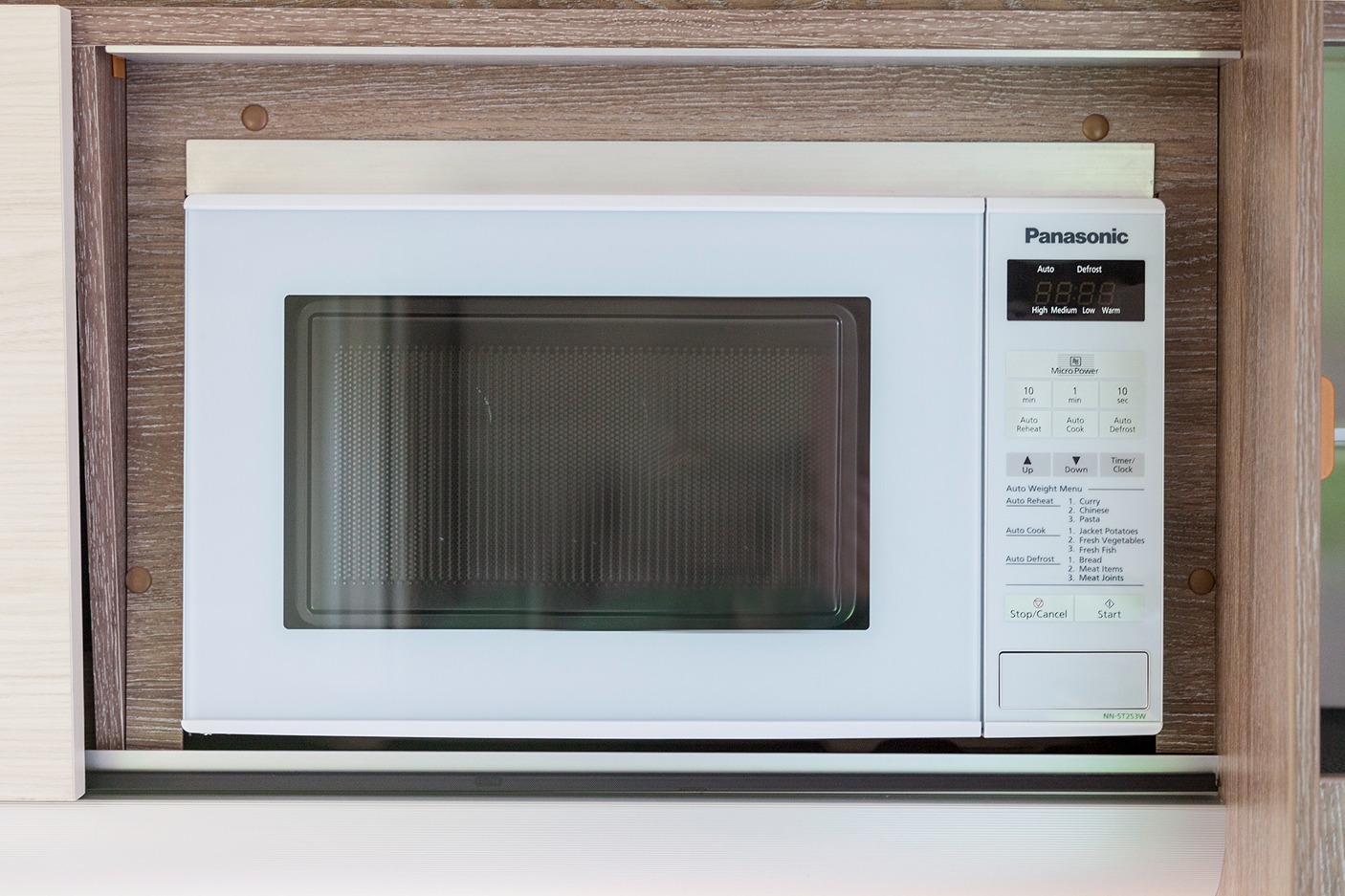
Popular kitchen appliances like microwave ovens, toasters and kettles work best when you’re hooked up to mains power in commercial campsites. If you plan to freedom camp most of the time, you probably won’t get much use out of them.
For this reason, many premium motorhome brands don’t include space for a microwave at all. Installing one and using it off-the-grid would consume your available house battery power and potentially cause issues with power surges.
To help choose a motorhome with your ideal kitchen, it’s important to assess your cooking preferences and lifestyle. Then, work out what extra appliances you really need and what you can do without.
Take into account the:
- Available space — in the motorhome kitchen area
- Number of power points — and where they’re located.
|
The power of an inverter Are you intending to use small appliances like a toaster, coffee machine or a stick blender in your motorhome kitchen? An inverter will enable some appliances to run via your 12V house battery while you’re freedom camping.
Find out more about inverters and how they work. |
Barbecue
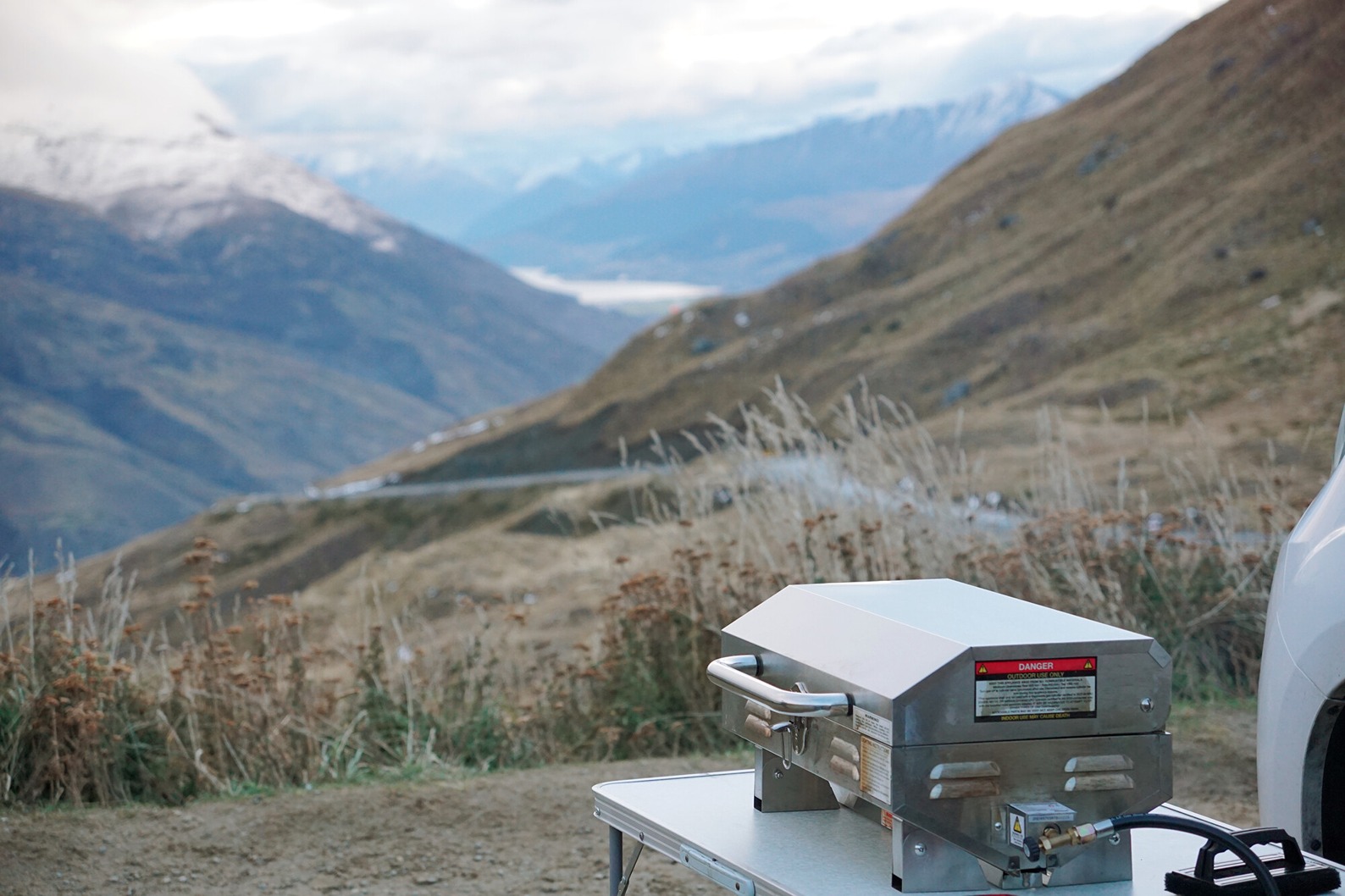
If you love cooking outdoors, a barbecue will be one item you’ll want to make room for. You can stow a lightweight barbecue in your motorhome’s garage, in an external locker or fixed to the side where it can slide in and out when needed.
Besides the novelty of creating an outdoor feast for the senses, you’ll enjoy additional benefits such as having more room to cook and keeping food smells outside your motorhome.
Check out our top ten essential accessories blog which features a barbecue.
Check there’s enough kitchen storage space
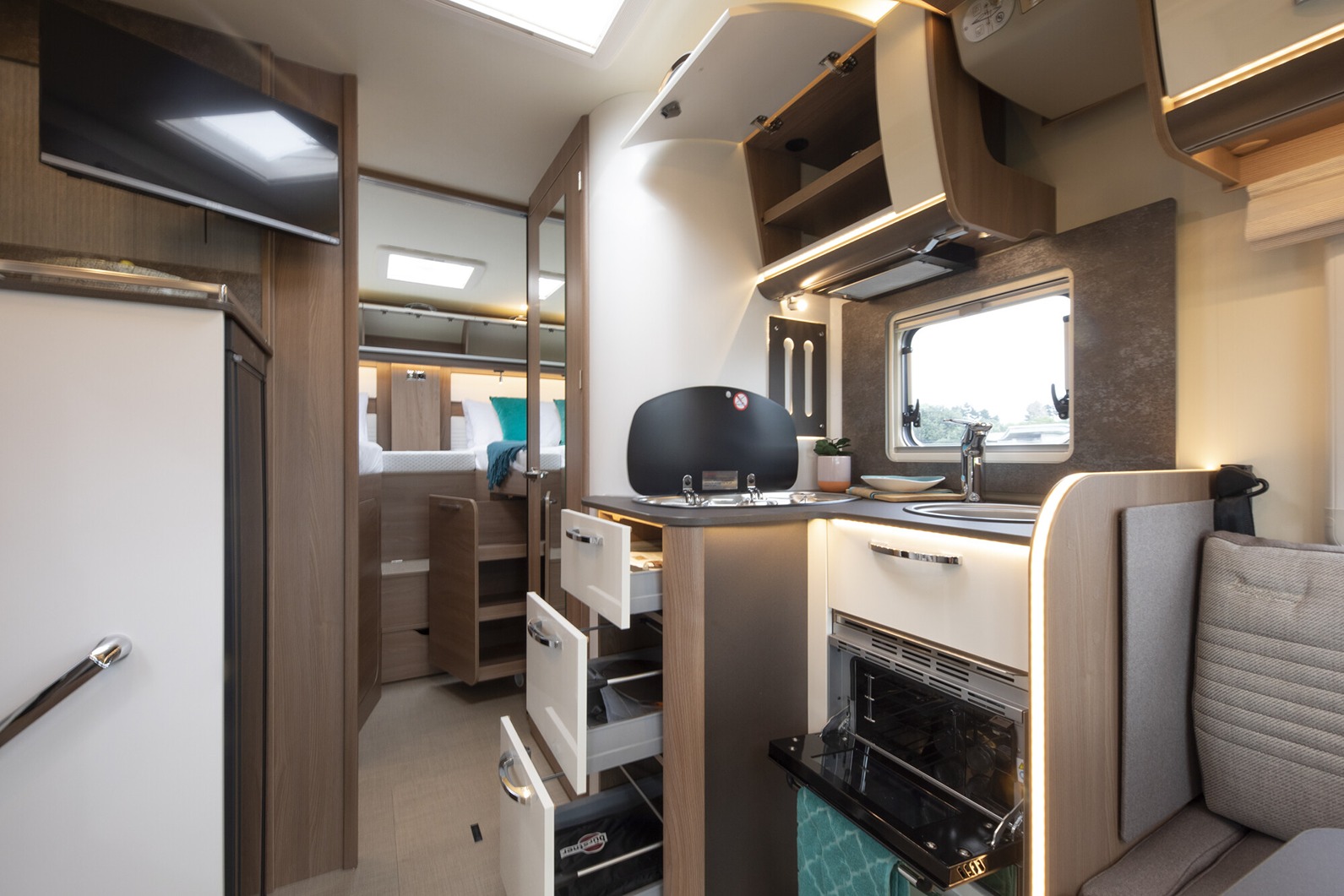
Storage space is always limited within motorhomes — and it’s no different inside the kitchen.
The size of your fridge can make a significant difference to how much food and drink you’re able to store. Pantry space is also important, particularly if you intend to camp off-grid for multiple days.
Cupboards, drawers and overhead lockers will house your pots, pans, plates, cups, utensils and dry foods. Many budget motorhomes have cavernous cupboards — making your items a little tricky to reach. Drawers are a better solution.
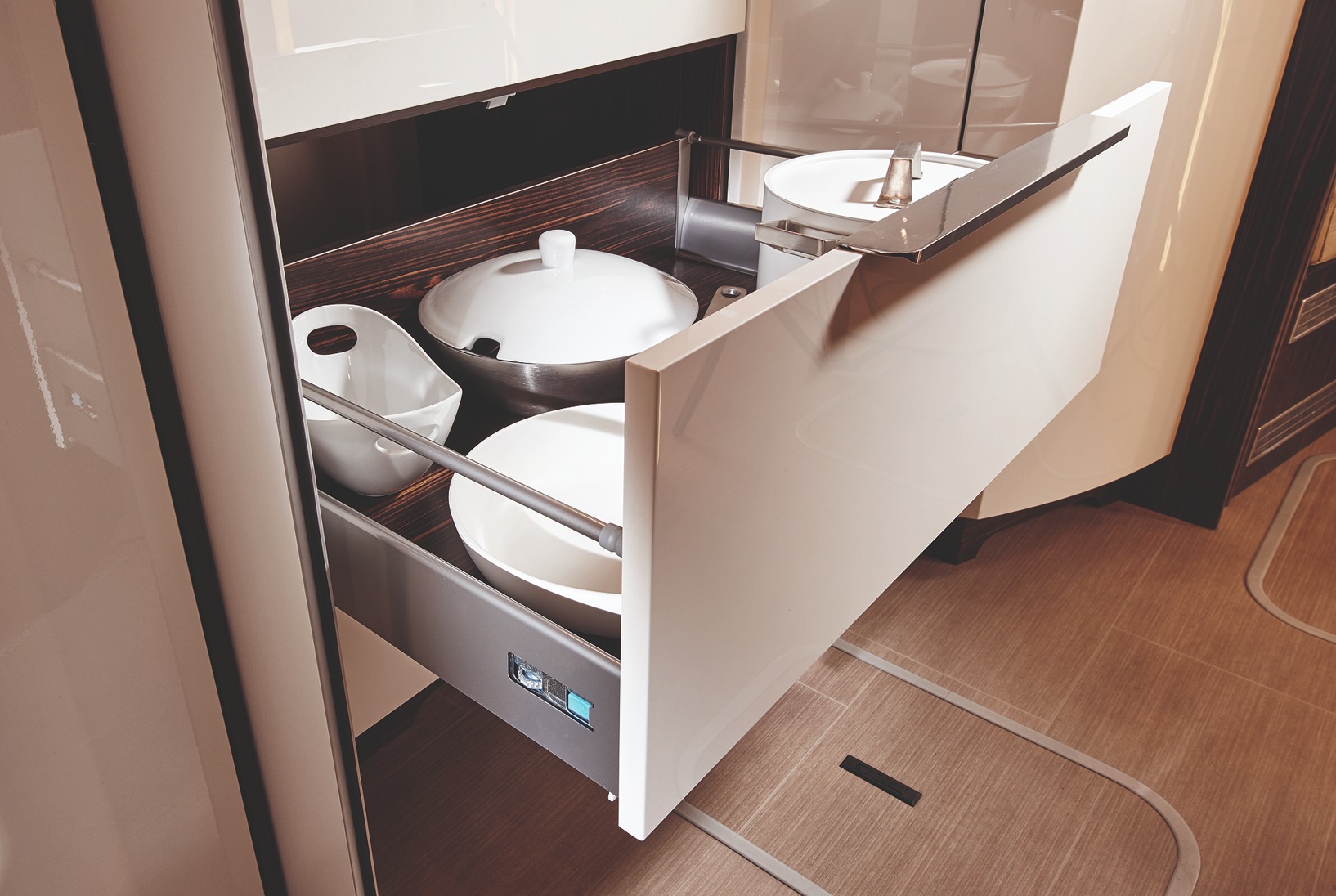
Some motorhomes have dedicated pantries while others may require you to get creative and spread your food items across different compartments. For heavier foodstuffs like tins, check if there’s sufficient underfloor storage space.
Learn how to organise your motorhome kitchen space to make great meals.
|
Kitchen storage checks
|
Take a close look at the kitchen lighting
A motorhome’s kitchen lighting not only affects how functional the space is — it also impacts your overall living experience. You’ll want to have enough natural and artificial lighting to help make the kitchen space highly functional.
Natural lighting
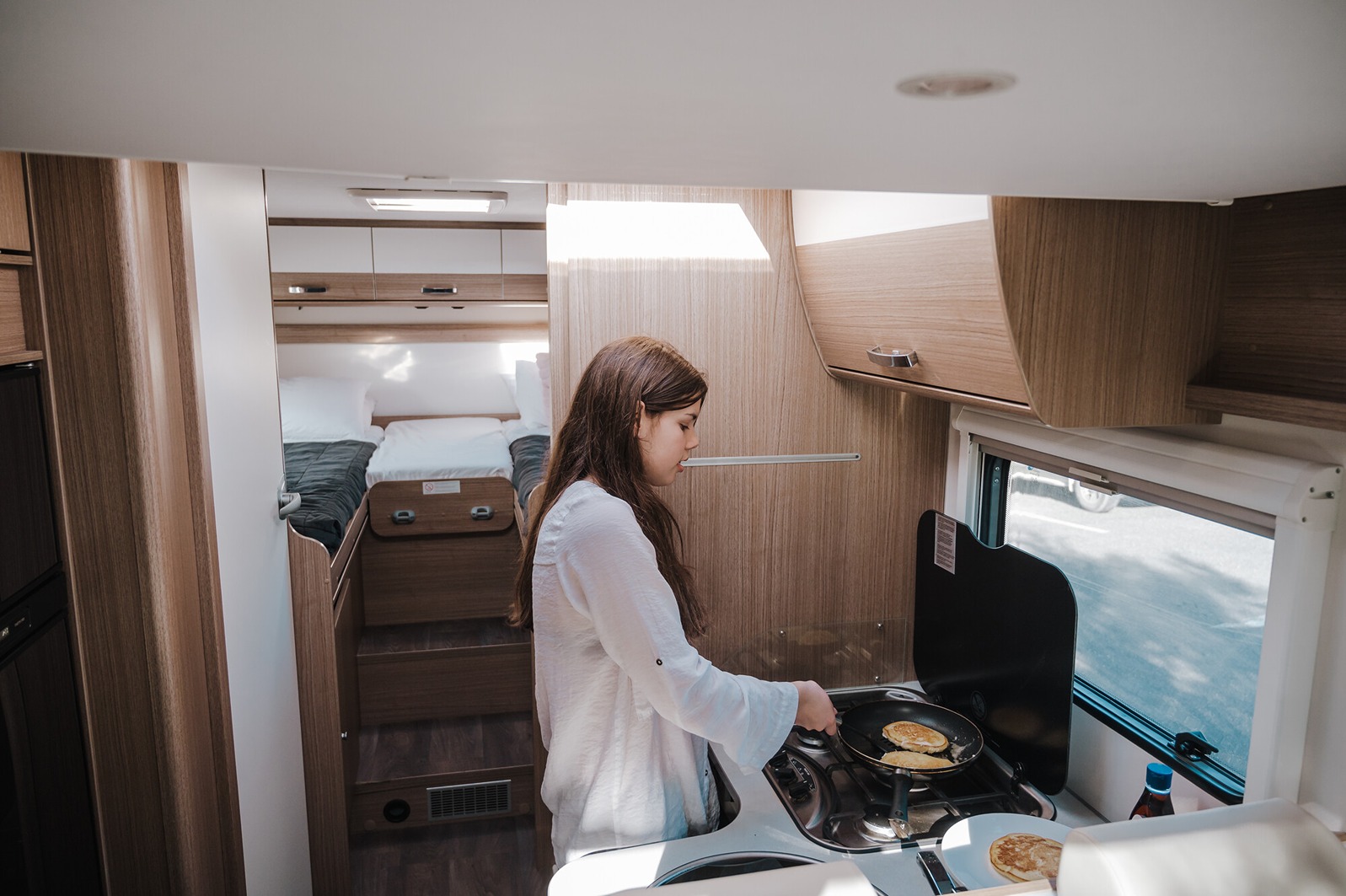
The right amount of natural light filtering into your motorhome’s kitchen will enhance the ambiance of the space and:
- Improve visibility — while you’re prepping and cooking food
- Create the feeling of a more relaxing, spacious and healthier environment
- Reduce your energy consumption — particularly vital if you’re off-the-beaten-track.
Task lighting
-lpr.jpg?width=1526&height=1017&name=RS22048_Cooking%20at%20Godley%20Head%2c%20Christchurch%20(2)-lpr.jpg)
Targeted task lighting helps focus light on specific areas like the bench space where you’ll be preparing food. Some of the advantages of task lighting in a motorhome kitchen are:
- Minimal shadows — ensuring consistent lighting across your preparation space
- Enhanced safety — inadequate lighting can increase your risk of burns, cuts and spills
- Improved ambience — creating a warm and inviting atmosphere for making meals.
Look for a motorhome with a functional kitchen layout, enough storage space, natural and focused lighting, and the ability to handle your appliances. Compromise will be necessary when considering all of these features — to ensure your kitchen space is one you’ll want to spend time in and prepare special meals for family and friends.
Learn more about the various types of lighting in motorhomes.
Be sure to do your due diligence as you’re going through the process of viewing and comparing motorhomes.
Download our motorhome due diligence checklist.


